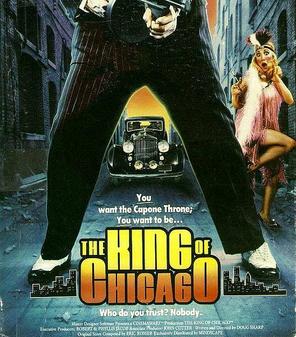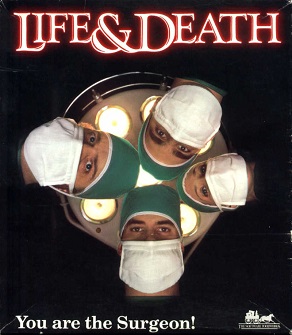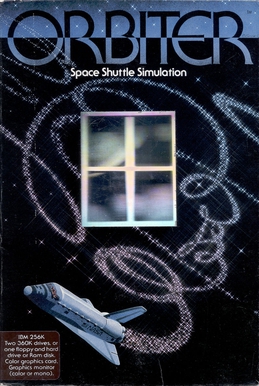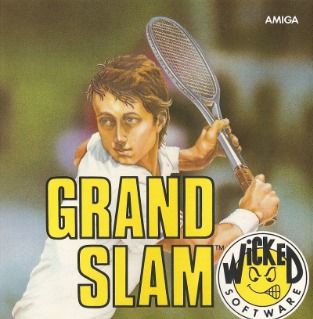
Balance of Power is a strategy video game of geopolitics during the Cold War, created by Chris Crawford and published in 1985 on the Macintosh by Mindscape, followed by ports to a variety of platforms over the next two years.

The Old Operating Theatre Museum and Herb Garret at 9a St Thomas Street is a museum of surgical history and one of the oldest surviving operating theatres. It is located in the garret of St Thomas's Church, Southwark, in London, on the original site of St Thomas' Hospital.

Top Banana is an environmentally-themed platform game produced by Hex and Psycore for the Acorn Archimedes in 1991 and ported to the Amiga and Atari ST in 1992. The chief artist and coder was Miles Visman, with supporting graphics and sound by Karel Dander, and supporting graphics by Sophie Smith, Robert Pepperell and Matt Black. Top Banana was released using recycled cardboard packaging, furthermore being advertised as being the 'first video game with recycled packaging'. Top Banana's plot is about trying to save the environment from pollution using love.

Dark Castle is a 1986 platform game for Macintosh that was originally published by Silicon Beach Software. The original game was designed and animated by Mark Pierce and programmed by Jonathan Gay with Real Sound by Eric Zocher. In Dark Castle, a young hero named Duncan tries to make his way to the evil Black Knight, dodging objects as well as solving occasional puzzles.

Skyfox is a combat flight simulation game developed by Ray Tobey for the Apple II and published by Electronic Arts in 1984. Ariolasoft published the game in Europe. It was released for the ZX Spectrum, Amstrad CPC, Commodore 64, and Macintosh in 1985, to the Amiga and Atari ST in 1986, and to the PC-88 in 1988.

The King of Chicago is a 1986 action-adventure video game by Doug Sharp. Based on numerous Hollywood mobster movies, this game is set in the 1930s, but some sequences towards the end of the game take place in 1986. The Macintosh version of the game is animated using claymation, while other versions utilize drawn graphics.

Portal is a text-driven adventure with a graphical interface published for the Amiga in 1986 by Activision. The writing is by American author Rob Swigart, and it was produced by Brad Fregger. Ports to the Commodore 64, Apple II, and IBM PC were later released. A version for the Atari ST was announced and developed, but not published. Until recently, it was thought that a Macintosh version was similarly developed yet left unpublished. The published Macintosh version was rediscovered in 2021 by a game collector.
A vascular bypass is a surgical procedure performed to redirect blood flow from one area to another by reconnecting blood vessels. Often, this is done to bypass around a diseased artery, from an area of normal blood flow to another relatively normal area. It is commonly performed due to inadequate blood flow (ischemia) caused by atherosclerosis, as a part of organ transplantation, or for vascular access in hemodialysis. In general, someone's own vein (autograft) is the preferred graft material for a vascular bypass, but other types of grafts such as polytetrafluoroethylene (Teflon), polyethylene terephthalate (Dacron), or a different person's vein (allograft) are also commonly used. Arteries can also serve as vascular grafts. A surgeon sews the graft to the source and target vessels by hand using surgical suture, creating a surgical anastomosis.

Life & Death is a computer game published in 1988 by The Software Toolworks. The player takes the role of an abdominal surgeon. The original packaging for the game included a surgical mask and gloves. A sequel, Life & Death II: The Brain, was published in 1990. In this sequel, the player is a neurosurgeon.

Rear admiral Sir William Watson Cheyne, 1st Baronet, was a Scottish surgeon and bacteriologist who pioneered the use of antiseptic surgical methods in the United Kingdom.

Medical simulation, or more broadly, healthcare simulation, is a branch of simulation related to education and training in medical fields of various industries. Simulations can be held in the classroom, in situational environments, or in spaces built specifically for simulation practice. It can involve simulated human patients, educational documents with detailed simulated animations, casualty assessment in homeland security and military situations, emergency response, and support for virtual health functions with holographic simulation. In the past, its main purpose was to train medical professionals to reduce errors during surgery, prescription, crisis interventions, and general practice. Combined with methods in debriefing, it is now also used to train students in anatomy, physiology, and communication during their schooling.

Bomber, also known as Bomber 3 or Bomber III, is a combat flight simulation game developed and released in 1989 by Inline Design for the Macintosh.

Harpoon is a computer wargame published by Three-Sixty Pacific in 1989 for DOS. This was the first game in the Harpoon series. It was ported to the Amiga and Macintosh.

Where in the U.S.A. Is Carmen Sandiego? is a video game that was released by Broderbund in 1986 and is part of the Carmen Sandiego series. The game is a sequel to 1985's Where in the World Is Carmen Sandiego?. A deluxe version with updated graphics and interface was released in 1992 and a remade version was released in 1996. The goal of the game is to track Carmen Sandiego's henchmen across the United States, arrest them, and ultimately arrest Carmen herself. The game received generally positive reviews but some critics compared it unfavorably with its predecessor game, which had a global perspective.

Sex Vixens from Space is an erotic interactive fiction game developed and self-published by Free Spirit Software and originally released in 1988 for the Commodore 64 and Apple II as part of the compilation Sex And Violence Vol. 1. It was released as a standalone game, with the addition of graphics, in November 1988 for DOS and Amiga and in 1989 for the Atari ST. Sex Vixens was inspired by the 1974 sexploitation film Flesh Gordon. The game was panned by reviewers.

Sex Olympics, alternatively titled Brad Stallion in Sex Olympics is an erotic point-and-click adventure game developed and self-published by Free Spirit Software, and released for DOS, Atari ST, and Amiga. The Amiga version of Sex Olympics was released in Europe in April 1991. Sex Olympics is the finale of the Brad Stallion series, and is preceded by Sex Vixens from Space (1988), Planet of Lust (1989), and Bride of the Robot (1989). Sex Olympics was panned by reviewers.

Planet of Lust is a 1989 erotic text adventure game developed and self-published by Free Spirit Software, and released for Commodore 64, DOS, Atari ST, and Amiga. The Amiga version of Planet of Lust was released in Europe in April 1989. Planet of Lust is the second game in the Brad Stallion series; it is preceded by Sex Vixens from Space (1988), and succeeded by Bride of the Robot (1989) and Sex Olympics (1991).

Orbiter is a 1986 video game published by Spectrum HoloByte.

Microsoft Flight Simulator is a 1986 video game developed by Sublogic and published by Microsoft for the Macintosh.

Grand Slam: World Class Tennis is a 1986 video game published by Infinity Software for Macintosh and Amiga.



















